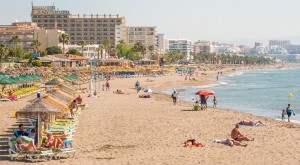
The sun, the sea, the sand: still Spain's biggest draws
Spain enjoyed a record-breaking year for tourism in 2013 when more than 60 million foreign nationals visited the country, according to latest official figures from Spain’s leading tourism association, Exceltur.
The association also found that overseas visitors spent a combined total of €45.1 billion, with Brits, Germans, French and the Russians making up the largest chunk of visitors…
Tourism is a key industry for Spain’s economy, making these figures extremely encouraging as the nation heads into 2014 buoyed by an upturn in fortunes almost across the board, from manufacturing to property. Only job creation remains a stagnant cause for concern for Prime Minister Mariano Rajoy.
“2013 was a really good year for Spain’s tourism industry, which gives us a lot of hope after some difficult years,” said Exceltur President, Armancio Lopez. “We think tourism should be an engine to help improve the Spanish economy, as it always has been.”
The sector accounts for approximately 10 per cent of Spain’s economy, which is on par with the country’s thriving automobile industry. These latest figures cement Spain’s place in the top three of the world’s most-visited country, where it regularly vies with France for top spot.
Despite working hard to shed its image as a destination for sun, sand and sangrias (a sophisticated marketing campaign extolling the virtues of its historic, beautiful and cosmopolitan cities was well received around Europe and the USA last year), the majority of visitors are still drawn by Spain’s delicious cocktail of warmth, great beaches, laid-back resorts and excellent range of nightclubs, bars and restaurants.
Property, too, is a key driver for growth, with lower prices helping to swell investment in holiday homes in some of Spain’s traditionally popular regions, namely the Costa del Sol, the Costa Brava and the Balearics.
Spain also benefited last year from the crises and political turmoil affecting some of its biggest rivals. Egypt, for example, lost an estimated 2.5 million tourists from June onwards as violent demonstrations in its capital city, Cairo, deterred holidaymakers from visiting popular year-round resorts found at Sharm el Sheikh.
“Curiously, at around that time, Spain’s tourists grew by 3 million,” said Luis Zoreda, treasurer of the Spanish Confederation of Travel Agencies, CEAV.
Away from the coastlines and cities such as Barcelona, Seville and Madrid, it was a different story, however. Spain’s interior – although beautiful and easily accessible – is a traditional destination of native Spaniards, but was hardly touched in 2013 as domestic demand remained suppressed in the face of continued job insecurity, high unemployment and low wages.
There were some chinks of hope, though. The Rioja region managed to attract more tourists last year thanks to a concerted effort to focus on wine tourism, drawing more overseas tourists than ever, and even managing to convince cash-strapped Spaniards to take some time away from their worries.
Other regions could learn from Rioja’s example, believes Zoreda, adding: “Spain must grow with a distinctive element of its own.”
Zoreda’s words were echoed by the president of the hotels confederation CEHAT, Juan Molas, who said that last year proved just how perennially popular Spain’s sun and beach tourism is. “You must not forget that 70 to 80 per cent of our visitors choose beach destinations. That is the great challenge for Spanish tourism: to sell and spread the word about all the tourism products in the rest of Spain.”
 en
en



 Vlaams-Nederlands
Vlaams-Nederlands
0 Comments
Leave a Comment
DISCLAIMER
The opinions and comments expressed by contributors to this Blog are theirs alone and do not necessarily reflect the views of VIVA Homes Under the Sun Ltd, any of its associated companies, or employees; nor is VIVA to be held responsible or accountable for the accuracy of any of the information supplied.
Have you got something to say?